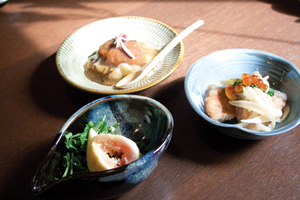Tradition, Reinvented
 Tradition rules in Kyoto. As if anyone needs to be reminded of that. Buddhist monks basically run the town, not politicians. One would be wise not to cross them. A family has to have lived there for generations to be considered true Kyoto. Snobbery? No, that’s just the way it is. Kyoto possesses a definite mystique, even down to the local dialect. Okini can mean thank you as much as it could mean screw you very much. Of course, traditions change. Population centers are subject to modernizing forces. Money often wins out. Witness the bright, new, modern Kyoto Station. Ancient temples have websites. The city naturally wants tourism revenue. Some things have to give. Others refuse to. Only time will tell if the latter can maintain relevance in the changing world. Kyoto’s food traditions are among its most well known, and also perhaps the most impervious to outside pressures. When the Michelin Guide came rolling into town, as if to lay proprietary claim to assessment of taste and quality, a few of the more revered restaurants said, “Okini.” Guess which meaning they intended. They wanted the editors to spend time in Kyoto, appreciate the greater history and context in which the food is being served. Not all of Kyoto’s Japanese restaurants are so observant of strict protocols, especially if they aren’t ‘locals’ in the Kyoto sense. O-men, which was only established in 1967, serves delicious seasonal varieties of udon (noodles) dishes, but offers guests something more, something different. Their noodles are of course homemade using 100% domestic wheat, and the seasonal vegetables and other ingredients are as fresh as can be. Recently, however, at the new Kodaiji location, master Shinagawa Kôta has been hosting pairing dinners of his dishes with selections of craft beer from Shizuoka’s Baird Beer or with exquisite sake. It’s hard to say whether gatekeepers of tradition gasp more at the fact that O-men has several branches (including New York!) or that they’re pairing traditional dishes with craft beer. But guests sure like the taste of the old and the new. Traditions, it seems, can be reinvented. |
京都は古くからの伝統が色濃く残る町。京都と聞いてまず伝統という言葉を連想する人は多いだろう。基本的にこの町で実権を握っているのは政治家ではなく僧侶のほうかもしれない。この町では特に僧侶に逆らわない方が賢明なのだ。そして何世代にもわたって京都に住んでその子孫がやっと真の京都人として認められるという雰囲気がある。とはいえ別に京都人がお高くとまっているわけでもない。京都の町はミステリアスな雰囲気に溢れ、京言葉と呼ばれる独特の方言にも不思議な響きがある。例えば「おおきに」という言葉は感謝の意を表すが、場合によっては人を小馬鹿にしているような印象を与えることもあるらしい。 伝統は時代と共に少しずつ移り変わってゆくもの。京都でも特に中心部は近代化の波にさらされている。カネがモノを言う世界が進出してきており、明るくモダンな京都駅ビルを見れば新しい京都のイメージに驚くだろう。古い寺院も今ではウェブサイトを持っていたりする。町としては観光収入が欲しいのは当然のこと。変化しながら生き残っていくものもあれば、変わることを拒んでいる世界もある。後者が今後も生き残っていけるのかは時が経ってみないと分からない。 京都を代表する伝統の一つに京料理があり、外部からの影響をほとんど受けないで受け継がれてきている。有名なミシュランガイドが京料理の評価のために京都にやって来た時、著名な日本料理店の中に「おおきに」と取材陣に返した店がいくつかあったという。感謝の意味だったのか、あるいは逆の意味だったのか?お店側はミシュランガイドの取材陣に対し、京都に来たならある程度ゆっくり時間を割いてその偉大な歴史と、京料理が持つ背景までよく勉強して欲しい、と注文を付けた。 老舗は別として、比較的新しい日本料理店の中にはそんなに形式にとらわれないところもある。例えば1967年創業の「京都銀閣寺名代おめん」は美味しいうどんを出すお店だが、ここは単なるうどん屋ではなく、新しい試みを行っているユニークなお店。国産小麦100%で作る自家製麺、季節の新鮮野菜とそれを使った薬味にもこだわり抜いているのだが、オーナーの品川さんは最近、静岡のクラフトビアであるベアードビールや美味しい日本酒と相性のいい料理を楽しむ会を高台寺店で開催している。。伝統を重んじる人たちからすれば、「おめん」がニューヨークにも進出している事実や、伝統料理とクラフトビアの組み合わせを提案している事実などにはびっくりするかもしれない。しかし、お客さんがその古いものと新しいものの組み合わせを楽しんでいることも事実。伝統とは改革されてゆくものなのかもしれない。 |








